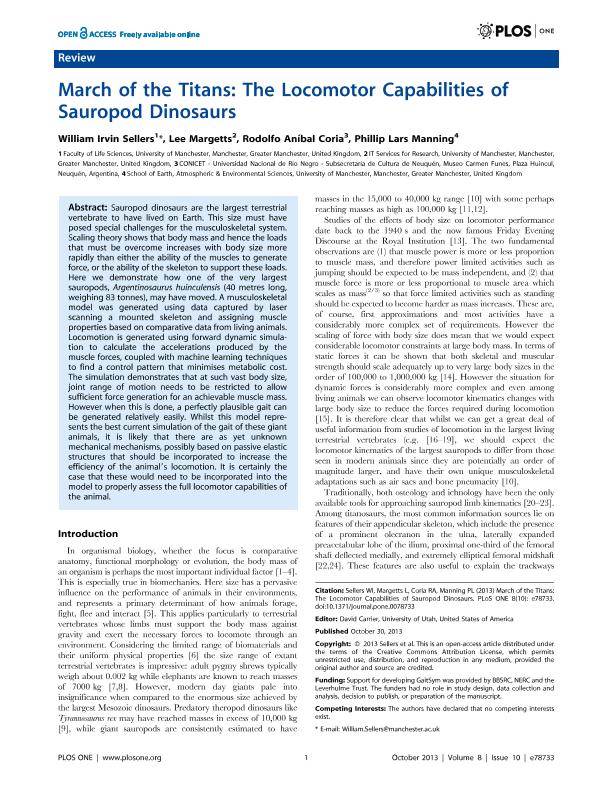Mostrar el registro sencillo del ítem
dc.contributor.author
Sellers, William Irvin
dc.contributor.author
Coria, Rodolfo Anibal

dc.contributor.author
Margetts, Lee
dc.contributor.author
Manning, Phillip Lars
dc.date.available
2015-04-24T19:05:42Z
dc.date.issued
2013-10-30
dc.identifier.citation
Sellers, William Irvin; Coria, Rodolfo Anibal; Margetts, Lee; Manning, Phillip Lars; March of the titans: The locomotor capabilities of sauropod dinosaurs; Public Library of Science; Plos One; 8; 10; 30-10-2013; 1-21; e78733
dc.identifier.issn
1932-6203
dc.identifier.uri
http://hdl.handle.net/11336/477
dc.description.abstract
Sauropod dinosaurs are the largest terrestrial vertebrate to have lived on Earth. This size must have posed special challenges for the musculoskeletal system. Scaling theory shows that body mass and hence the loads that must be overcome increases with body size more rapidly than either the ability of the muscles to generate force, or the ability of the skeleton to support these loads. Here we demonstrate how one of the very largest sauropods, Argentinosaurus huinculensis (40 metres long, weighing 83 tonnes), may have moved. A musculoskeletal model was generated using data captured by laser scanning a mounted skeleton and assigning muscle properties based on comparative data from living animals. Locomotion is generated using forward dynamic simulation to calculate the accelerations produced by the muscle forces, coupled with machine learning techniques to find a control pattern that minimises metabolic cost. The simulation demonstrates that at such vast body size, joint range of motion needs to be restricted to allow sufficient force generation for an achievable muscle mass. However when this is done, a perfectly plausible gait can be generated relatively easily. Whilst this model represents the best current simulation of the gait of these giant animals, it is likely that there are as yet unknown mechanical mechanisms, possibly based on passive elastic structures that should be incorporated to increase the efficiency of the animal9s locomotion. It is certainly the case that these would need to be incorporated into the model to properly assess the full locomotor capabilities of the animal.
dc.format
application/pdf
dc.language.iso
eng
dc.publisher
Public Library of Science

dc.rights
info:eu-repo/semantics/openAccess
dc.rights.uri
https://creativecommons.org/licenses/by-nc-sa/2.5/ar/
dc.subject
Titanosaurs
dc.subject
Locomotion
dc.subject
Argentinosaurus
dc.subject.classification
Paleontología

dc.subject.classification
Ciencias de la Tierra y relacionadas con el Medio Ambiente

dc.subject.classification
CIENCIAS NATURALES Y EXACTAS

dc.title
March of the titans: The locomotor capabilities of sauropod dinosaurs
dc.type
info:eu-repo/semantics/article

dc.type
info:ar-repo/semantics/artículo
dc.type
info:eu-repo/semantics/publishedVersion

dc.date.updated
2016-03-30 10:35:44.97925-03
dc.journal.volume
8
dc.journal.number
10
dc.journal.pagination
1-21; e78733
dc.journal.pais
Estados Unidos

dc.journal.ciudad
San Francisco
dc.description.fil
Fil: Sellers, William Irvin. University of Manchester; Reino Unido
dc.description.fil
Fil: Coria, Rodolfo Anibal. Universidad Nacional de Río Negro; Argentina. Consejo Nacional de Investigaciones Científicas y Técnicas; Argentina
dc.description.fil
Fil: Margetts, Lee. University of Manchester; Reino Unido
dc.description.fil
Fil: Manning, Phillip Lars. University of Manchester; Reino Unido
dc.journal.title
Plos One

dc.relation.alternativeid
info:eu-repo/semantics/altIdentifier/doi/http://dx.doi.org/10.1371/journal.pone.0078733
dc.relation.alternativeid
info:eu-repo/semantics/altIdentifier/url/http://journals.plos.org/plosone/article?id=10.1371/journal.pone.0078733
Archivos asociados
